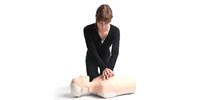The Chain of Survival
What is the Chain of Survival all about? It is certainly about Early Access, Early CPR, Early Defibrillation and Early ACLS. It is also about a series of critical interventions, coordinated roles and responsibilities. But what the Chain of Survival is truly about is survival itself.
A life saved.
That’s why Providers do what they do. It’s not about the lights and sirens – it’s all about the patient and good patient care. It’s about a strong Chain in the Community. Community CPR, and PAD. Because we know that a strong Chain increases the chances for survival from sudden cardiac arrest.
Why do Laerdal products, solutions and services support the Chain of Survival? Because we know that there is no greater image than that of a recovered sudden cardiac arrest patient leaving the hospital and beginning to live the rest of his or her life.
Our modern lifestyles make cardiac arrest the number one killer. Two out of every three deaths occur before the victims even reach the hospital. The losses to families and costs to communities are enormous.
“Survival of cardiac arrest depends on a series of critical interventions. If one of these critical actions is neglected or delayed, survival is unlikely.
The American Heart Association has used the term Chain of Survival to describe this sequence.”*
Some communities with a strong Chain of Survival report survival rates as high as 30%. A series of related and connected events, the Chain of Survival defines the roles of bystanders, dispatchers, first responders, emergency service personnel, paramedics, doctors and nurses, coordinated as a team to help save lives.
* Emergency Cardiac Care Committee and Subcommittees. American Heart Association.






